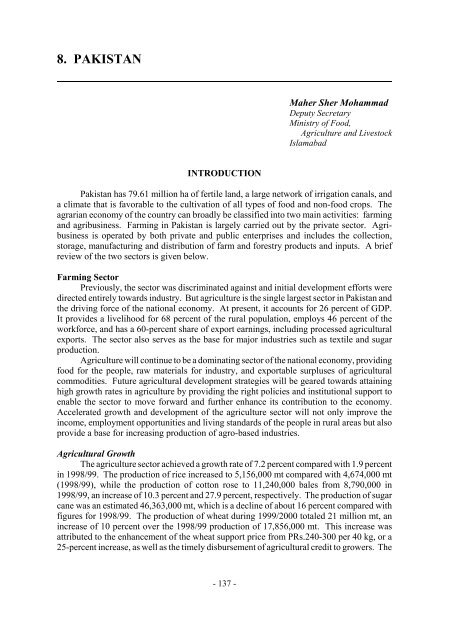Development of Agribusiness Enterprises - Asian Productivity ...
Development of Agribusiness Enterprises - Asian Productivity ...
Development of Agribusiness Enterprises - Asian Productivity ...
You also want an ePaper? Increase the reach of your titles
YUMPU automatically turns print PDFs into web optimized ePapers that Google loves.
8. PAKISTAN<br />
INTRODUCTION<br />
- 137 -<br />
Maher Sher Mohammad<br />
Deputy Secretary<br />
Ministry <strong>of</strong> Food,<br />
Agriculture and Livestock<br />
Islamabad<br />
Pakistan has 79.61 million ha <strong>of</strong> fertile land, a large network <strong>of</strong> irrigation canals, and<br />
a climate that is favorable to the cultivation <strong>of</strong> all types <strong>of</strong> food and non-food crops. The<br />
agrarian economy <strong>of</strong> the country can broadly be classified into two main activities: farming<br />
and agribusiness. Farming in Pakistan is largely carried out by the private sector. <strong>Agribusiness</strong><br />
is operated by both private and public enterprises and includes the collection,<br />
storage, manufacturing and distribution <strong>of</strong> farm and forestry products and inputs. A brief<br />
review <strong>of</strong> the two sectors is given below.<br />
Farming Sector<br />
Previously, the sector was discriminated against and initial development efforts were<br />
directed entirely towards industry. But agriculture is the single largest sector in Pakistan and<br />
the driving force <strong>of</strong> the national economy. At present, it accounts for 26 percent <strong>of</strong> GDP.<br />
It provides a livelihood for 68 percent <strong>of</strong> the rural population, employs 46 percent <strong>of</strong> the<br />
workforce, and has a 60-percent share <strong>of</strong> export earnings, including processed agricultural<br />
exports. The sector also serves as the base for major industries such as textile and sugar<br />
production.<br />
Agriculture will continue to be a dominating sector <strong>of</strong> the national economy, providing<br />
food for the people, raw materials for industry, and exportable surpluses <strong>of</strong> agricultural<br />
commodities. Future agricultural development strategies will be geared towards attaining<br />
high growth rates in agriculture by providing the right policies and institutional support to<br />
enable the sector to move forward and further enhance its contribution to the economy.<br />
Accelerated growth and development <strong>of</strong> the agriculture sector will not only improve the<br />
income, employment opportunities and living standards <strong>of</strong> the people in rural areas but also<br />
provide a base for increasing production <strong>of</strong> agro-based industries.<br />
Agricultural Growth<br />
The agriculture sector achieved a growth rate <strong>of</strong> 7.2 percent compared with 1.9 percent<br />
in 1998/99. The production <strong>of</strong> rice increased to 5,156,000 mt compared with 4,674,000 mt<br />
(1998/99), while the production <strong>of</strong> cotton rose to 11,240,000 bales from 8,790,000 in<br />
1998/99, an increase <strong>of</strong> 10.3 percent and 27.9 percent, respectively. The production <strong>of</strong> sugar<br />
cane was an estimated 46,363,000 mt, which is a decline <strong>of</strong> about 16 percent compared with<br />
figures for 1998/99. The production <strong>of</strong> wheat during 1999/2000 totaled 21 million mt, an<br />
increase <strong>of</strong> 10 percent over the 1998/99 production <strong>of</strong> 17,856,000 mt. This increase was<br />
attributed to the enhancement <strong>of</strong> the wheat support price from PRs.240-300 per 40 kg, or a<br />
25-percent increase, as well as the timely disbursement <strong>of</strong> agricultural credit to growers. The
















